牛津英语八年级上Unit 3 A day out 教案
- 格式:doc
- 大小:1.05 MB
- 文档页数:14
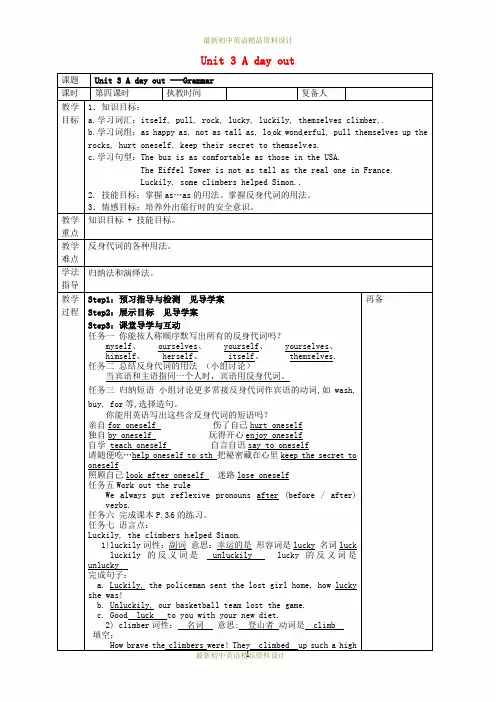
Unit 3 A day out课题Unit 3 A day out ---Grammar课时第四课时执教时间复备人教学目标1.知识目标:a.学习词汇:itself, pull, rock, lucky, luckily, themselves climber,.b.学习词组:as happy as, not as tall as, lo ok wond erful, pull themselves up the rocks, hurt oneself, keep their secret to themselv es.c.学习句型:The bus is as comfortable as those in the USA.The Eiffel Tower is not as tall as the real one in France.Luckily, some climbers helped Simon..2. 技能目标:掌握as…as的用法。
掌握反身代词的用法。
3.情感目标:培养外出旅行时的安全意识。
教学重点知识目标 + 技能目标。
教学难点反身代词的各种用法。
学法指导归纳法和演绎法。
教学过程Step1:预习指导与检测见导学案Step2:展示目标见导学案Step3:课堂导学与互动任务一你能按人称顺序默写出所有的反身代词吗?myself、 ourselves、 yourself、 yourselves、himself、 herself、 itself、 themselves.任务二总结反身代词的用法(小组讨论)当宾语和主语指同一个人时,宾语用反身代词。
任务三归纳短语小组讨论更多常接反身代词作宾语的动词,如wash, buy, for等,选择造句。
你能用英语写出这些含反身代词的短语吗?亲自for oneself 伤了自己hurt oneself独自by oneself 玩得开心enjoy oneself自学 teach oneself 自言自语say to oneself请随便吃…help oneself to sth 把秘密藏在心里keep the secret to oneself照顾自己look after oneself 迷路lose oneself任务五Work out the ruleWe always put reflexive pronouns after (before / after)verbs.任务六完成课本P.36的练习。
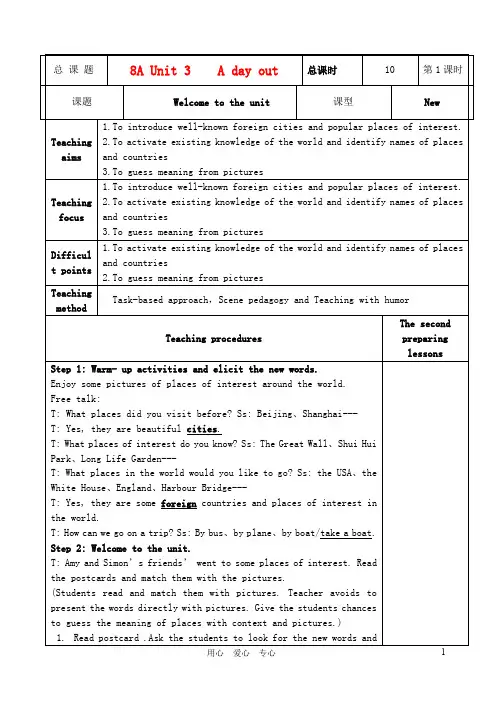
江苏省淮北中学英语学科教案
初二年级教案活页纸主备人:陈小军审核人:初二英语组全体老
江苏省淮北中学英语学科教案
初二年级教案活页纸主备人:陈小军审核人:初二英语组全体老
江苏省淮北中学英语学科教案
初二年级教案活页纸主备人:陈小军审核人:初二英语组全体老
江苏省淮北中学英语学科教案
初二年级教案活页纸主备人:陈小军审核人:初二英语组全体老
师
初二年级教案活页纸主备人:陈小军审核人:初二英语组全体老
江苏省淮北中学英语学科教案
初二年级教案活页纸主备人:陈小军审核人:初二英语组全体老
江苏省淮北中学英语学科教案
江苏省淮北中学英语学科教案。

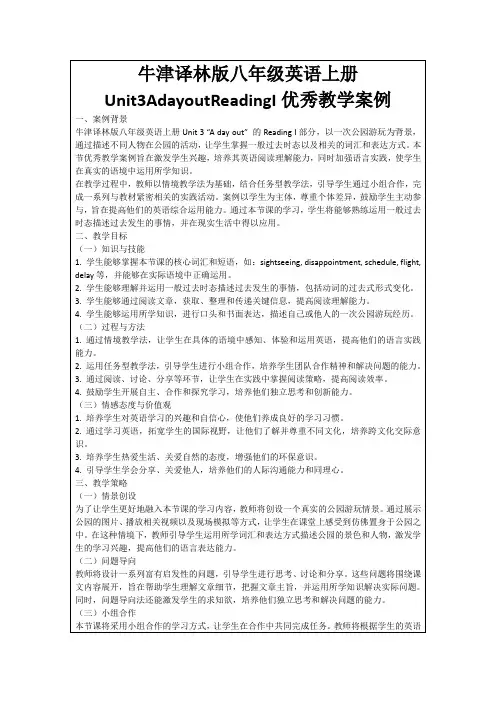
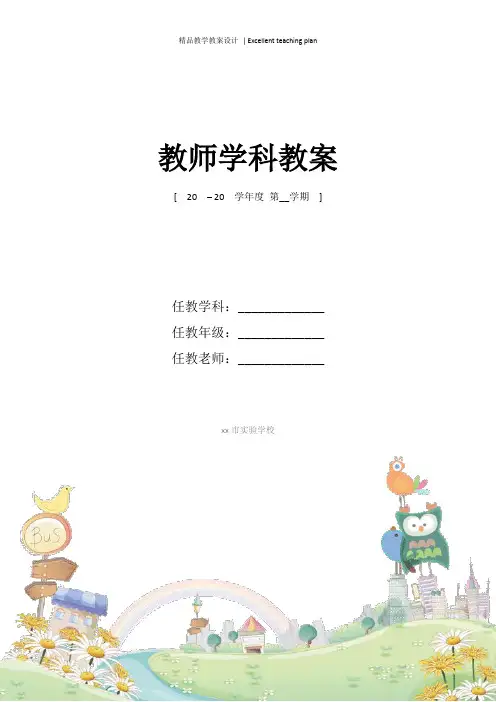
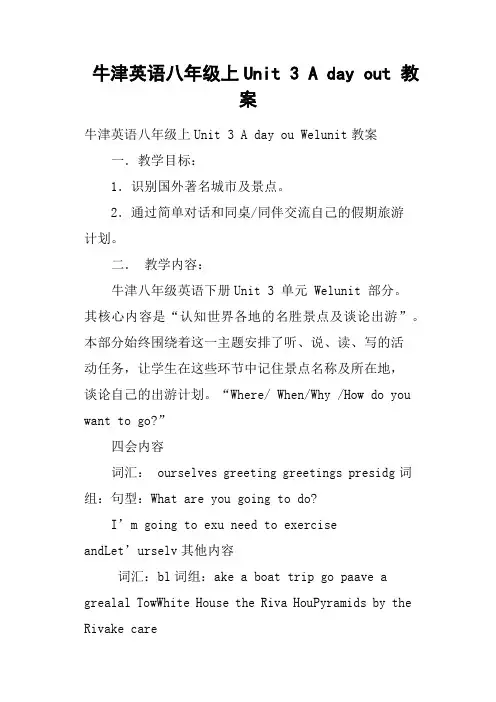
牛津英语八年级上Unit 3 A day out 教案牛津英语八年级上Unit 3 A day ou Welunit教案一.教学目标:1.识别国外著名城市及景点。
2.通过简单对话和同桌/同伴交流自己的假期旅游计划。
二.教学内容:牛津八年级英语下册Unit 3 单元 Welunit 部分。
其核心内容是“认知世界各地的名胜景点及谈论出游”。
本部分始终围绕着这一主题安排了听、说、读、写的活动任务,让学生在这些环节中记住景点名称及所在地,谈论自己的出游计划。
“Where/ When/Why /How do you want to go?”四会内容词汇: ourselves greeting greetings presidg词组:句型:What are you going to do?I’m going to exu need to exerciseandLet’urselv其他内容词汇:bl词组:ake a boat trip go paave a grealal TowWhite House the Riva HouPyramids by the Rivake care三.教学准备1.录音机2.多媒体四、学情分析及教学策略本课话题来自学生的生活经历,在以前的学习中,学生已经学习了许多动词短语及形容词,为表达提供了语言基础。
此外,学生已掌握了特殊疑问词Where/When/What/Why/How进行提问, 为本课的学习做了铺垫。
具有了学习本单元知识的认知前提,能自然的与本单元的话题衔接。
本部分内容贴近生活,学生比较容易进入角色。
因而,教师在课堂中应通过场景图片来促使学生积极地参与,在任务型教学活动中,使学生有话想说,有话可说,在完成各项任务的过程中自主学习语言,提高他们综合运用语言的能力,学会更好地与他人沟通。
使各层次的学生都有所收获。
五.教学步骤:呈现1 向学生提问:If you awhat are you going to do? 帮助学生练习I’m going to…待学生回答后问:What do youddie is going to d? 鼓励学生大胆猜测。
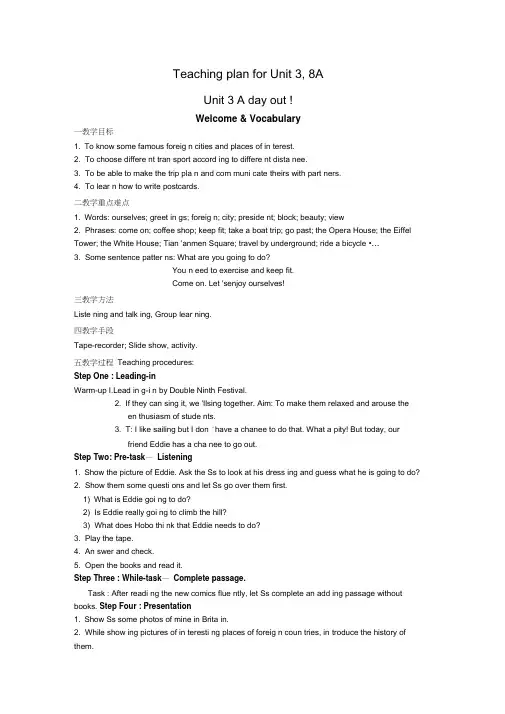
Teaching plan for Unit 3, 8AUnit 3 A day out !Welcome & Vocabulary一教学目标1. To know some famous foreig n cities and places of in terest.2. To choose differe nt tran sport accord ing to differe nt dista nee.3. To be able to make the trip pla n and com muni cate theirs with part ners.4. To lear n how to write postcards.二教学重点难点1. Words: ourselves; greet in gs; foreig n; city; preside nt; block; beauty; view2. Phrases: come on; coffee shop; keep fit; take a boat trip; go past; the Opera House; the Eiffel Tower; the White House; Tian 'anmen Square; travel by underground; ride a bicycle •…3. Some sentence patter ns: What are you going to do?You n eed to exercise and keep fit.Come on. Let 'senjoy ourselves!三教学方法Liste ning and talk ing, Group lear ning.四教学手段Tape-recorder; Slide show, activity.五教学过程Teaching procedures:Step One : Leading-inWarm-up I.Lead in g-i n by Double Ninth Festival.2. If they can sing it, we 'Ilsing together. Aim: To make them relaxed and arouse theen thusiasm of stude nts.3. T: I like sailing but I don 'have a chanee to do that. What a pity! But today, ourfriend Eddie has a cha nee to go out.Step Two: Pre-task—Listening1. Show the picture of Eddie. Ask the Ss to look at his dress ing and guess what he is going to do?2. Show them some questi ons and let Ss go over them first.1) What is Eddie goi ng to do?2) Is Eddie really goi ng to climb the hill?3) What does Hobo thi nk that Eddie needs to do?3. Play the tape.4. An swer and check.5. Open the books and read it.Step Three : While-task—Complete passage.Task : After readi ng the new comics flue ntly, let Ss complete an add ing passage without books. Step Four : Presentation1. Show Ss some photos of mine in Brita in.2. While show ing pictures of in teresti ng places of foreig n coun tries, in troduce the history of them.3. To display the n ame of capital and city on the Map of the World.Step Five : Practice1. Based on lear ning the places of in terest around the world, let Ss match the places with thepictures.2. Through liste ning, check if Ss remember the content I taught.Step Seven : Post-task1. T: Nick, Leo and Jane are in the different foreign countries. Let ' read their postcards and findout where they are?2. Free-Qs: let Ss ask some questi ons each other accord ing to the three postcardsFor example: What did Nick do there?/ Where did Leo write the postcard?/ How did Nick travel?...3. In troduce how to write a postcard to lay foreshadow ing for the further lear ning.4. To alter nate a situati on to recall the tran sports Ss've lear nt before.Step Eight : Further-learning1. Just now, Ss visited lots of foreig n coun tries. Now show some pictures of Beiji ng, China,such as Tian'anmen Square; the Monument to the People 'Heroes; the Great Wall; theTemple of Heave n; the Palace Museum; Laoshe Tea House; Wangfujing Street …2. After teach ing and lear nin g, let Ss remind the n ames of these in teresti ng places in Beiji ng. Step Nine: Consolidation1. Ex 1: to fill in the bla nks with some places of in terest.2. Ex 2:Accord ing to the in troducti on, choose differe nt tran sports.Step Ten: Expansion1. Discussi on: let Ss discuss the places of in terest in hometow n Chan gzhou in groups.Aim:Through this discuss ing activity, it makes Ss establish or foster con fide nee and go on patriotic educatio n.2. Make a trip pla n for Chan gzhou.3. Accord ing to their pla n, com muni cate with their partn ers.Step Eleven: WritingAccord ing to the pla n, write a postcard.Situati on 1: You have visited the places of in terest.Situati on 2: You want to visit the places of in terest.Step Twelve:VideoWhile watchi ng, request Ss to write dow n the places of in terest they saw.Step Thirteen:Homework1. Recite the dialogue of comic strip.2. Write an in vitati on to your friends accord ing to your pla n.教学后记。
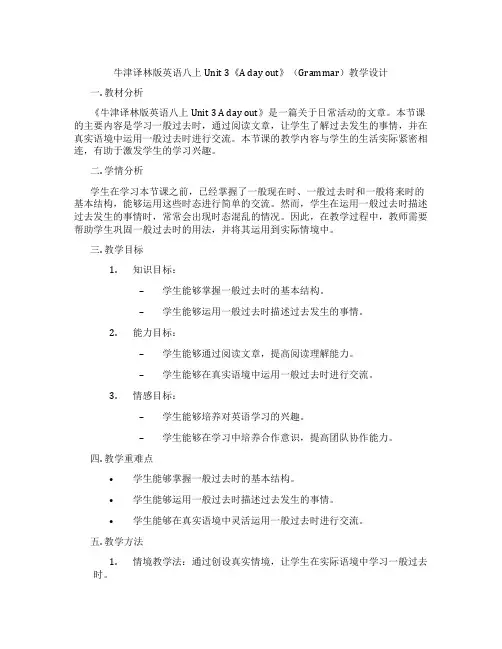
牛津译林版英语八上Unit 3《A day out》(Grammar)教学设计一. 教材分析《牛津译林版英语八上Unit 3 A day out》是一篇关于日常活动的文章。
本节课的主要内容是学习一般过去时,通过阅读文章,让学生了解过去发生的事情,并在真实语境中运用一般过去时进行交流。
本节课的教学内容与学生的生活实际紧密相连,有助于激发学生的学习兴趣。
二. 学情分析学生在学习本节课之前,已经掌握了一般现在时、一般过去时和一般将来时的基本结构,能够运用这些时态进行简单的交流。
然而,学生在运用一般过去时描述过去发生的事情时,常常会出现时态混乱的情况。
因此,在教学过程中,教师需要帮助学生巩固一般过去时的用法,并将其运用到实际情境中。
三. 教学目标1.知识目标:–学生能够掌握一般过去时的基本结构。
–学生能够运用一般过去时描述过去发生的事情。
2.能力目标:–学生能够通过阅读文章,提高阅读理解能力。
–学生能够在真实语境中运用一般过去时进行交流。
3.情感目标:–学生能够培养对英语学习的兴趣。
–学生能够在学习中培养合作意识,提高团队协作能力。
四. 教学重难点•学生能够掌握一般过去时的基本结构。
•学生能够运用一般过去时描述过去发生的事情。
•学生能够在真实语境中灵活运用一般过去时进行交流。
五. 教学方法1.情境教学法:通过创设真实情境,让学生在实际语境中学习一般过去时。
2.任务型教学法:通过完成各种任务,提高学生的阅读理解能力和口语表达能力。
3.合作学习法:通过小组合作,培养学生的团队协作能力和沟通能力。
六. 教学准备1.教师准备:–制作PPT,展示文章内容和相关图片。
–准备教学道具,如图片、卡片等。
2.学生准备:–预习课文,了解文章大意。
–复习一般过去时的基本结构。
七. 教学过程1.导入(5分钟)教师通过提问方式引导学生回顾一般过去时的基本结构,如“What did you do yesterday?”,激发学生的学习兴趣。
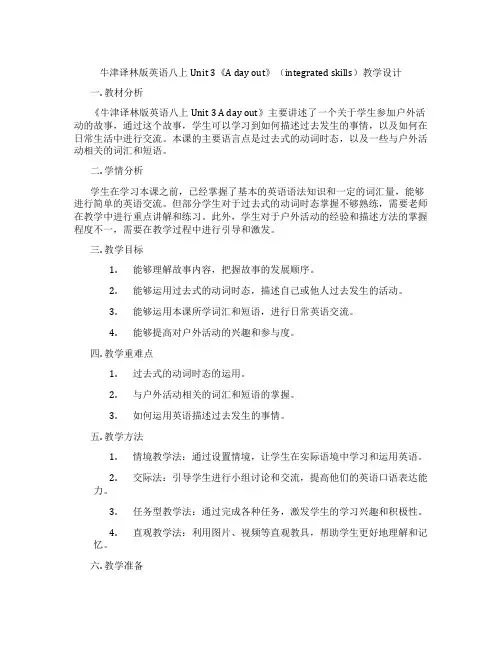
牛津译林版英语八上Unit 3《A day out》(integrated skills)教学设计一. 教材分析《牛津译林版英语八上Unit 3 A day out》主要讲述了一个关于学生参加户外活动的故事,通过这个故事,学生可以学习到如何描述过去发生的事情,以及如何在日常生活中进行交流。
本课的主要语言点是过去式的动词时态,以及一些与户外活动相关的词汇和短语。
二. 学情分析学生在学习本课之前,已经掌握了基本的英语语法知识和一定的词汇量,能够进行简单的英语交流。
但部分学生对于过去式的动词时态掌握不够熟练,需要老师在教学中进行重点讲解和练习。
此外,学生对于户外活动的经验和描述方法的掌握程度不一,需要在教学过程中进行引导和激发。
三. 教学目标1.能够理解故事内容,把握故事的发展顺序。
2.能够运用过去式的动词时态,描述自己或他人过去发生的活动。
3.能够运用本课所学词汇和短语,进行日常英语交流。
4.能够提高对户外活动的兴趣和参与度。
四. 教学重难点1.过去式的动词时态的运用。
2.与户外活动相关的词汇和短语的掌握。
3.如何运用英语描述过去发生的事情。
五. 教学方法1.情境教学法:通过设置情境,让学生在实际语境中学习和运用英语。
2.交际法:引导学生进行小组讨论和交流,提高他们的英语口语表达能力。
3.任务型教学法:通过完成各种任务,激发学生的学习兴趣和积极性。
4.直观教学法:利用图片、视频等直观教具,帮助学生更好地理解和记忆。
六. 教学准备1.教学PPT:包括故事内容、词汇和短语、语法点等。
2.图片和视频素材:与户外活动相关的图片和视频。
3.练习题:针对本课内容设计的练习题。
4.教学道具:如户外活动用品等。
七. 教学过程1.导入(5分钟)老师通过提问方式引导学生谈论自己参加户外活动的经历,激发学生的学习兴趣。
2.呈现(10分钟)老师通过PPT呈现故事内容,让学生整体感知文本。
同时,老师讲解过去式的动词时态,让学生理解和掌握。
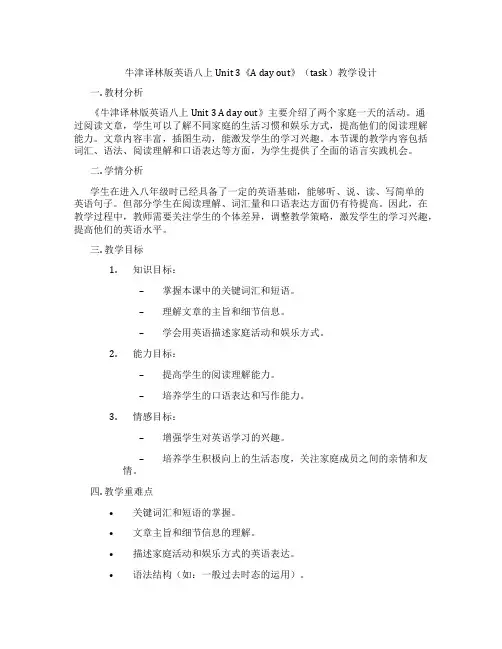
牛津译林版英语八上Unit 3《A day out》(task)教学设计一. 教材分析《牛津译林版英语八上Unit 3 A day out》主要介绍了两个家庭一天的活动。
通过阅读文章,学生可以了解不同家庭的生活习惯和娱乐方式,提高他们的阅读理解能力。
文章内容丰富,插图生动,能激发学生的学习兴趣。
本节课的教学内容包括词汇、语法、阅读理解和口语表达等方面,为学生提供了全面的语言实践机会。
二. 学情分析学生在进入八年级时已经具备了一定的英语基础,能够听、说、读、写简单的英语句子。
但部分学生在阅读理解、词汇量和口语表达方面仍有待提高。
因此,在教学过程中,教师需要关注学生的个体差异,调整教学策略,激发学生的学习兴趣,提高他们的英语水平。
三. 教学目标1.知识目标:–掌握本课中的关键词汇和短语。
–理解文章的主旨和细节信息。
–学会用英语描述家庭活动和娱乐方式。
2.能力目标:–提高学生的阅读理解能力。
–培养学生的口语表达和写作能力。
3.情感目标:–增强学生对英语学习的兴趣。
–培养学生积极向上的生活态度,关注家庭成员之间的亲情和友情。
四. 教学重难点•关键词汇和短语的掌握。
•文章主旨和细节信息的理解。
•描述家庭活动和娱乐方式的英语表达。
•语法结构(如:一般过去时态的运用)。
•阅读理解中长难句的解析。
•口语表达和写作能力的提升。
五. 教学方法1.任务型教学法:通过完成各种任务,激发学生的学习兴趣,培养他们的实践能力。
2.交际法:创设真实情境,让学生在交流中学会运用英语。
3.情境教学法:利用插图和多媒体手段,帮助学生更好地理解文章内容。
4.小组合作学习:鼓励学生互相讨论、分享,提高课堂参与度。
六. 教学准备1.教材:《牛津译林版英语八上Unit 3 A day out》2.多媒体课件:包括文章音频、图片、视频等教学资源3.学习任务单:用于引导学生进行自主学习和合作学习4.答案卡片:用于核对学生答案七. 教学过程1.导入(5分钟)教师通过提问方式引导学生回顾上一单元学到的内容,如家庭成员的名字和特点。
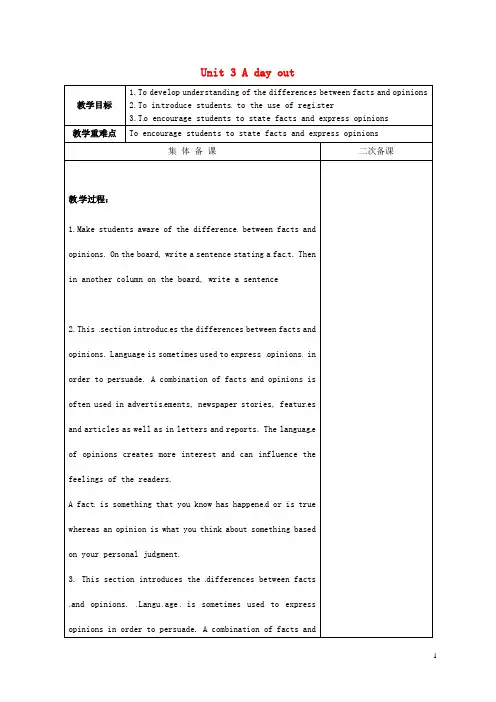
Unit 3 A day outTaskI. Teaching aims and learning objectivesBy the end of the lesson, students should be able to:1. know the form of a trip plan and understand what a trip plan is;2. write a trip plan;3. grasp the structure of an invitation letter;4. write an invitation letter.II. Teaching contents1. New words and phrases: plan a day out, square, see the biggest city square in the world,take the underground/bus to …, by underground/walk to …,on foot,visit the garden and row boats, go back to…, per student 2. New structure: We are planning a day out on …It will take about … minutes/hour(s) to get to …Then /After that /Next, we will go to…on foot/walk to …The cost is about … per student.III. Focus of the lesson and predicted area of difficultyDevelop students’ writing ability.IV. Teaching proceduresStep 1 Lead-in1. Guessing gameT: Today we’ll learn Task of Unit 3. Now let’s play a game. I will give some clues. Canyou tell me these places are? Are you ready? Let’s begin.2. Watch a video about places of interest in YangzhouT: If you are free, are you going to visit places of interest? Watch the video first.【设计意图】利用猜谜游戏复习前面的内容,用动感的视频创设情境,提高学生的学习热情,导入到新课。
Unit 3 A day outPeriod 1【教学目标】1.To introduce the topic ‘A day out’.2.To introduce the famous places around the world and the countries students belong to.【教学重难点】1.To develop fluency in talking about the places students would like to go.2.To talk about places of interest around the world.【教学过程】Step 1 Presentation1.Have a free talk. Ask: If you have some free time, what are you going to do? I’m going to…2.Show a picture of Eddie to the students and get the students to guess what you think. Eddie is going to do if he has some free time.3.Ask the students ‘Usually, Eddie is a very lazy dog. Do you think he is going to climb the hill? Let’s listen to the tape and f ind out the answer.’4.Listen to the tape and get the student to answer the question.Is Eddie really going to climb the hill? No, he isn’t.What is he going to do? He is going to eat some food.5.Ask another three questions one by one orally for the students to answer.Does he wants to exercise? (Yes, he does.) Does he wants to keep fit? (No, he doesn’t.)Step 2 Practice1.Say open you books, please. Let’s repeat Eddie and Hobo’s conversation after the tape.2.Now the boys will be Eddie and the girls will be Hobo. Read the conversation. Pay attention to your pronunciation and intonation.3.Practice the conversation in pairs. You have five minutes. You can add your own ideas if you want.4.Ask several pairs to act it out.Step 3 Presentation1.Show a map of the world.Here’s a map of the worl d.Look at it and tell me the countries you know about. Get the students to talk about their own experiences. Then ask them ‘Do you want to travel to foreign countries? (Yes.) Do you know about these places?’2.Elicit what they know about the countries and their capitals. We can use the pictures (Mount Fuji, the Statue of Liberty, the Eiffel Tower, Big Ben, Saint Basil’s Cathedral). Look at the pictures in my hand.Do you know the name of this famous building? Do you know where it is? Write these places on the blackboard and read aloud.3.To talk about more countries, we can use a world map and at the same time we talk about some famous places in the countries.Show more pictures and teach the famous places that are going to appear in the reading material. Ask questions: ‘Which countr y is it in? Which city is it in?’4.Discuss the postcards on the book.Step 4 Practice1.After reading the postcards from his friends, Simon searched on the Internet for some information about places around the world. Which place of interest are Simon and Amy talking about?2.Play the tape and answer some questions.3.How long is the Golden Gate Bridge?4.How wide is the bridge?5.Play the tape again, repeat after the tape.6.Now this half of the class will read Amy’s part and the other half will read Simon’s part. Then we change parts.7..Get the students to make up dialogues using Simon and Amy’s as a model.Step 5 Homework1.Recite comic strip2.Preview reading【板书设计】Unit 3 Comic strip and welcome to the unitThe Opera House Washington FranceThe Eiffel Tower Sydney the USAThe White House Paris Australia【教学反思】Most of the students understand the passages well, and most of them can read and write the new words and useful expressions correctly.。
牛津译林版英语八上Unit 3《A day out》(integrated skills)说课稿一. 教材分析《牛津译林版英语八上Unit 3 A day out》是一篇关于周末活动的阅读文章。
通过描述作者在周末参观历史悠久的城市牛津的经历,让学生在阅读过程中了解英国的文化和历史背景。
这篇文章紧贴学生的生活实际,激发他们对英语学习的兴趣,并培养他们的阅读能力。
二. 学情分析针对八年级的学生,他们已经具备了一定的英语基础,对文章中的词汇和语法知识点有一定的了解。
但他们在阅读理解方面还需提高,特别是对长篇文章的阅读和理解能力。
此外,学生对英国文化和历史背景的了解相对较少,需要在教学过程中进行补充和引导。
三. 说教学目标1.知识目标:学生能够掌握文章中的核心词汇和短语,理解文章的主旨大意。
2.能力目标:学生能够提高阅读理解能力,学会从文章中获取和处理信息。
3.情感目标:学生能够激发对英国文化和历史的兴趣,培养跨文化交际的意识。
四. 说教学重难点1.重点:学生能够理解文章的主旨大意,掌握文章中的核心词汇和短语。
2.难点:学生能够运用阅读技巧,从文章中获取和处理信息,提高阅读理解能力。
五. 说教学方法与手段1.教学方法:采用任务型教学法,让学生在完成任务的过程中提高阅读理解能力。
2.教学手段:利用多媒体课件、图片、地图等辅助教学,帮助学生更好地理解文章内容。
六. 说教学过程1.导入:通过展示牛津大学的图片,引导学生谈论自己对英国文化的了解,激发学习兴趣。
2.阅读理解:学生自主阅读文章,完成相关练习题,教师引导学生讨论答案,解答疑问。
3.词汇学习:教师讲解文章中的核心词汇和短语,学生跟读并模仿发音。
4.文化背景:教师介绍英国文化和历史背景,帮助学生更好地理解文章内容。
5.小组讨论:学生分组讨论文章中的细节信息,锻炼合作能力和阅读理解能力。
6.总结:教师引导学生总结文章主旨,回顾所学知识点。
七. 说板书设计板书设计包括文章标题、核心词汇、短语以及教学重点句子。
牛津译林版八年级上册Unit 3《A day out》(Grammar 1)教学设计一. 教材分析《A day out》是人教版牛津译林英语八年级上册Unit 3的教学内容,主要介绍了一般过去时态的用法。
本课以一位学生参加野餐的一天为背景,通过描述所做的事情,让学生学会运用一般过去时态描述过去发生的动作。
教材内容丰富,插图生动,有利于激发学生的学习兴趣。
二. 学情分析八年级的学生已经学习过一般现在时态,对时态的概念有一定的了解。
但一部分学生可能对一般过去时态的用法掌握不够扎实。
因此,在教学过程中,需要关注学生的个体差异,针对性地进行辅导。
此外,学生对英语学习的兴趣和积极性较高,有利于开展本课的教学活动。
三. 教学目标1.知识目标:让学生掌握一般过去时态的构成和用法,能正确运用一般过去时态描述过去发生的动作。
2.能力目标:培养学生运用英语进行交流的能力,提高学生的听说读写技能。
3.情感目标:激发学生学习英语的兴趣,培养学生的团队协作精神和自主学习能力。
四. 教学重难点1.重点:一般过去时态的构成和用法。
2.难点:一般过去时态在实际语境中的运用。
五. 教学方法1.情境教学法:通过设定情境,让学生在实际语境中学习一般过去时态。
2.交际法:鼓励学生进行小组讨论,培养学生的口语表达能力。
3.任务型教学法:通过完成任务,让学生在实践中掌握一般过去时态的用法。
六. 教学准备1.教学课件:制作课件,展示相关图片和情境。
2.野餐场景图:准备一张野餐场景的图片,用于引导学生进行描述。
3.作业纸:准备一份练习题,用于巩固所学知识。
七. 教学过程1.导入(5分钟)利用课件展示一张野餐场景的图片,引导学生观察并提问:“What can you see in the picture? What are they doing?”,激发学生的学习兴趣。
2.呈现(10分钟)介绍一般过去时态的构成和用法,通过举例解释一般过去时态的概念。
牛津译林版英语八上Unit 3《A day out》(Reading1)教学设计一. 教材分析《A day out》是人教版牛津译林英语八年级上册Unit 3的一篇阅读文章。
文章讲述了一个叫Jim的男孩在周末和父亲一起去郊外游玩的经历。
在游玩过程中,他们遇到了一系列有趣的事情,从而让Jim对生活有了新的认识。
这篇文章内容丰富,情节生动,语言简单易懂,适合初中生阅读。
通过学习这篇课文,学生可以提高自己的阅读理解能力,扩展词汇量,学习日常英语交际用语,并培养对生活的积极态度。
二. 学情分析八年级的学生已经具备了一定的英语基础,能够理解和运用一些基本的英语句型和词汇。
但他们在阅读理解、词汇量和口语交际方面还存在一定的困难。
因此,在教学过程中,教师需要关注学生的个体差异,因材施教,尽量让每个学生都能在课堂上得到锻炼和提高。
三. 教学目标1.知识目标:让学生掌握文章中的关键词汇和句型,提高阅读理解能力。
2.能力目标:通过阅读和实践活动,培养学生运用英语进行交际的能力。
3.情感目标:引导学生从文章中体会生活的美好,培养积极的生活态度。
四. 教学重难点1.重点:文章中的关键词汇和句型。
2.难点:理解文章的主旨大意,运用英语进行日常交际。
五. 教学方法1.任务型教学法:通过完成各种任务,激发学生的学习兴趣,提高学生的参与度。
2.交际型教学法:通过小组讨论、角色扮演等活动,培养学生的英语交际能力。
3.情境教学法:创设真实的语境,帮助学生更好地理解和运用英语。
六. 教学准备1.教材:人教版牛津译林英语八年级上册Unit 3《A day out》。
2.多媒体设备:电脑、投影仪、音响等。
3.教学素材:相关图片、视频、PPT等。
4.作业布置:提前让学生预习课文,了解文章大意。
七. 教学过程1.导入(5分钟)利用多媒体展示一些关于户外活动的图片,如徒步、野餐、钓鱼等,引导学生谈论自己喜欢的户外活动。
然后简要介绍本节课要学习的文章《A day out》。